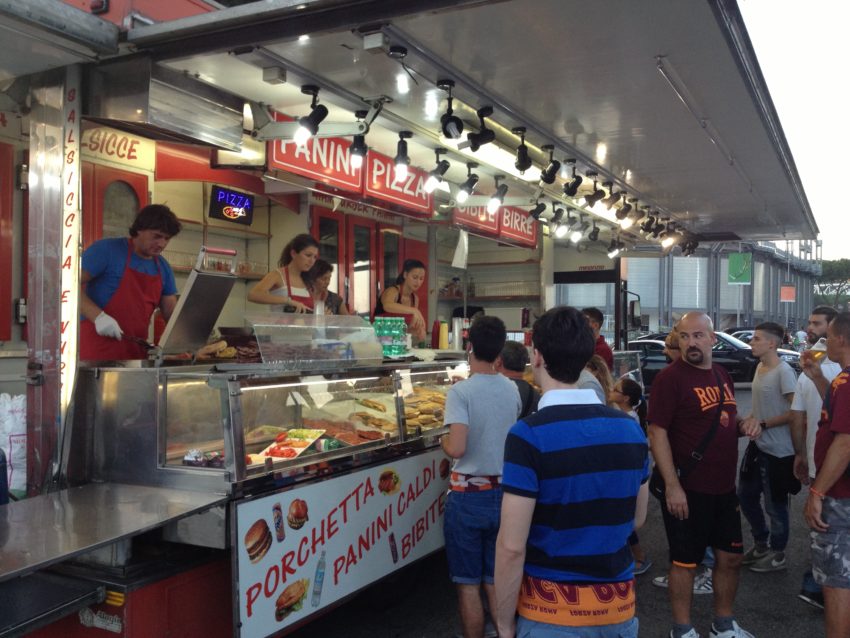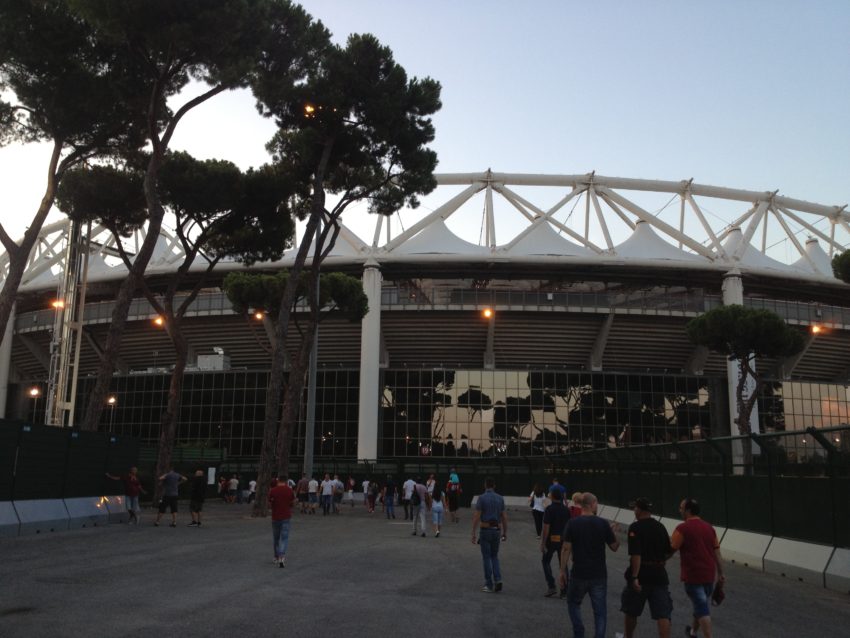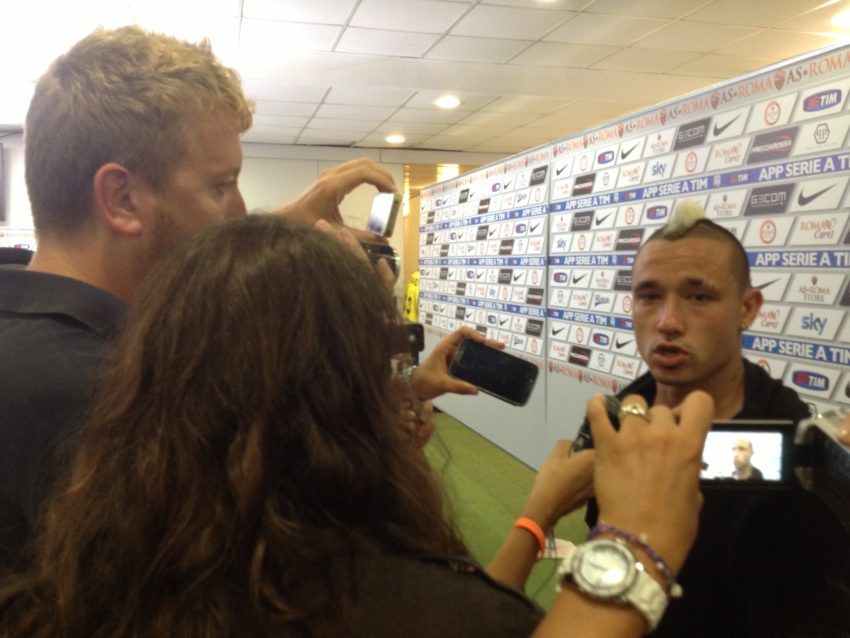Retired in Rome Journal: Opening day of football season — Roman style

AUG. 31
It’s the opening weekend of the football season on two continents. Last night I went to the one here in Europe where I didn’t see a single tailgate party, marching band or coed passed up through the stands. Juventus and A.S. Roma won their opening games without a single benefit from an animal mascot on the sideline.
However, so much of what I’ve experienced in this lead up to A.S. Roma’s season reminds me of my 23 years in Denver. Just like before the Broncos season, the city of Rome is buzzing as if the whole town is about to give birth for the first time. New additions coming off A.S. Roma’s highest point total in history have breathless columnists predicting its fourth Serie A (Italian national league) in its 86-year history. Old men in my cafe are talking soccer every morning. I’m overhearing soccer conversations in the gym. A.S. Roma’s red and yellow colors are flying more, whether they’re flags from apartment buildings or jerseys off store shelves. I’m forming bonds with complete strangers just by pulling out my A.S. Roma keychain.
“Sono un lupetto,” I say in reference to the Italian word for small wolf, Roma’s mascot and its fans’ handle.
This isn’t just heady stuff for a city that’s nearly bankrupt, in money and in morale. It’s also big for me, whose emotional link to any American sports team pretty much ended in 1975 when I sat through my school’s 5-0 loss to San Jose State in a driving rainstorm my junior year at Oregon. Reading a zip code directory was more interesting. But like Detroit latching onto the Tigers or New York riding the Yankees-Mets World Series out of the stomach-turning cauldron of 9-11, Rome needs a team to help its citizens forget their lives, even if it is for only two hours a couple times a week.
Romans are not happy. Their image of smiling faces around sun-splashed tables stacked with food and wine has been replaced by a daily struggle to make ends meet. Italy’s worst economic crisis since World War II has given A.S. Roma its biggest burden of all: Give Romans a reason to smile.

It may be bigger than the current one weighing on its shoulders like a gladiator’s coat of armor. It’s favored to win it all. A La Gazzetta dello Sport poll of experts Saturday showed it’s picked to end Juventus’ streak of three straight titles. This is practically the same Juventus roster that broke a Serie A record last season with 102 points, with a mark of Crimson Tide-ish 33 wins, two losses and three ties. The same poll showed Roma’s Miralem Pjanic, the diminutive Bosnian midfielder, as the best player in Serie A, one of three Roma players in the poll’s top five. Romans are looking up from their red ink and to see their team wearing red has become a European power. There are so many reasons why this season could be one of the ages in this nearly 3,000-year-old city:
* Additions of defender Ashley Cole, the England national team player from Chelsea; striker Juan Manuel Iturbe, known “as the new Lionel Messi,” from Verona; and defender Kostas Manolas, fresh off the Greek World Cup team, have given Roma depth at every position. Six strikers could start for about every team in Italy.
* Juventus, which has 30 Serie A titles, nearly twice as many as any other club, didn’t improve as much in the off season and new coach Massimiliano Allegri faces the mind-numbing pressure of succeeding in the Champions League. Juve hasn’t advanced past the quarterfinals in the European club championships since 2003. In Turin, Serie A titles are starting to feel like good night pecks on the cheek.
* Roma is in the Champions League for the first time in four seasons. Serie A is the target but visits from defending champion Bayern Munich and Manchester City will jack up Roma’s European profile.
* Developments keep surfacing on Roma’s new 52,000-seat, $415 million stadium planned for 2016-17. Roma’s dynamic new American owner from Boston, James Pallotta, is using private funds to make Roma a team for the future. Stadium drawings I’ve seen make it look like a spaceship.

With this promising landscape as a backdrop, I took the long bus ride from my home in Testaccio, on the south end of Rome and where A.S. Roma was born in 1927, to venerable Stadio Olimpico on the north end. Approaching at dusk, you wonder why anyone would leave this international sports landmark. Roman statues and Mediterranean pine trees line the walkway as you approach the round stadium with its trademark triangular-design roof lit up like a king’s crown. But then you get inside. The corridors are sterile and shabby. The boring VIP areas could double as cheap cafes. The neutral dark-blue seats make it look like any stadium from Sao Paulo to St. Petersburg. The place was built for the 1960 Olympics for God’s sake. Wilma Rudolph ran here.
Roma opened with Fiorentina, the upstart team from Florence picked fourth in the league and coached by former Roma star Vincenzo Montella, “L’Aeroplanino” who used to celebrate goals by holding his arms out straight and pretending to fly around the field. After his four goals beat hated rival Lazio 5-1 in 2002, wildly smiling Romans were shown on TV cruising around on their Vespas, arms outstretched, as if they were flying instead of steering. Now 40, he’s one of the up-and-coming young coaches and matched wits with Rudi Garcia, the Frenchman who arrived last season from Lille, in the French league, and became Rome’s most popular leader since Augustus.
The game started like an opener in any sport. Roma looked tight. Some of its passes went straight to Fiorentina which is young and confident with terrific ballhandlers. But it doesn’t have the experience or, maybe, the destiny of Roma. In the 27th minute, Belgian Radja Nainggolan ran toward the Fiorentina goal and passed ahead to Gervinho, the Ivory Coast striker who may be the fastest player in Serie A. Goalkeeper Norberto Neto made a great block — right back to Nainggolan who drove it into a half-empty net.
The goal stood up until Gervinho’s breakaway goal just before the final buzzer. Goalkeeper Morgan De Sanctis made some brilliant diving saves. Venerable Francesco Totti, the Joe DiMaggio of Serie A, looked fit and effective. The 44,353 fans who nearly packed the stadium made more noise than I ever heard in Denver’s Sports Authority Field.
Even the Curva Sud behaved. The holding pen, er, section for Roma’s vicious ultra fans, produced no off-color signs or chants. Neither did they throw any bananas when Fiorentina’s Colombian star, Guillermo Cuadrado, touched the ball. It was in Fiorentina Italian Cup final against Napoli May 3 when Napoli fan Ciro Esposito was killed outside Stadio Olimpico. The atmosphere was ripe for abuse. Maybe a communique on the Roma fans’ website urging each other to start anew gave them long-awaited dignity.

After the game reminded me of why I don’t miss my job as a sportswriter. I waited with the other Italian media for an hour in the mixed zone to interview players. We got one from Roma. Nainggolan and his yellow mohawk graced us for about 15 minutes. Pannotta walked through, translator in tow. I asked him how opening day in soccer in Rome compares with opening day in baseball in Boston
“It’s not even close,” said the silver-haired Pallotta, wearing his trademark sportcoat sans tie. “While Boston fans are as good and crazy as any, it’s a different atmosphere. I was really pleased with how Curva Sud acted. They supported the guys on the team as well as everyone else. I expect this every game.”
While his man translated, he turned back to me, knowing I’m about the only reporter in the mob who understood him.
“The Celtics are a different story,” he said.
“How’s your Italian?” I asked him.
“It could be a lot better.”
If this team meets expectations, Pallotta could talk medieval Bulgarian and the fans will hang on his every word. Right now one soccer team is about to lift Rome out of one of the worst depressions in its history. The smiles are back on Romans’ faces. Wine glasses are raised once again. The football season in Rome has begun.
This morning when I went to my newsstand, I picked up a copy of Corriere dello Sport, featuring seven pages of game coverage and 12 stories. I pointed out the end-of-the-world headline “SUBITO ROMA” (ROMA QUICKLY) to the middle-aged man behind the counter. I said the fans’ catch phrase, “Forza Roma! (Go Roma!)”
“Sempre! (Always!)” he said with a smile.

